










Drafted by: John Culpepper ~ Former North Country School & Camp Treetops Director of Facilities and Sustainability
While this operating manual is about using our design to compost food waste, I believe that we have demonstrated a pathway to process all organics from towns and villages throughout the developing world, creating business opportunities and reducing environmental problems. In efect, I believe that this composter design has the potential to positively impact a billion people on the planet.

In 2016, North Country School & Camp Treetops, in partnership with the Adirondack North Country Association (ANCA), received a $35,000 grant through the New York State Energy Research and Development Authority (NYSERDA) to design a low cost, in-vessel drum composter for medium to large organizations. This pilot composter was so successful that $120K was awarded by NYSERDA to build and install 3 additional units. North Coun-try School/Camp Treetops opted to distribute the 3 systems to remote site hosts. Concurrently, a boarding school in New Jersey has constructed and is operating a system following the North Country School & Camp Treetops model, leading project designer and lead, John Culpepper to realize the need for a document to support current and future organizations and individuals operat-ing the in-vessel composter design. I have drafted this operation manual to offer such support.
All of the ideas that led to the development of this system are a result of time spent with people smarter than, or more experienced than me. I was simply the conduit through which this idea of designing and building an in-vessel composter came to be. I acknowledge legions of others who have inspired, taught, or otherwise helped me in this. I also acknowledge and appreciate the extent to which various executive directors at North Country School & Camp Treetops, and the all-volunteer board of trustees have allowed me the opportunity to explore this and many other sustainability initiatives for our campus. I would like to express my appreciation to the following individuals and organizations whose support has allowed me to experiment with various versions of this project:
Greg LeClair – technical assistance and manufacturing
NYSERDA – grant funds and technical assistance
The Cloudsplitter Foundation – grant funds for education and outreach
Melissa Hart – graphic design
ANCA – NYSERDA project management
Jennifer Perry – grant management

North Country School & Camp Treetops is an indepen-dent boarding school and summer camp that has been in operation since 1921.
North Country School & Camp Treetops prides itself in its long standing commitment to sustainability with an extensive portfolio of closed loop operations including an on-site farm, multiple biomass heating systems, 2 net zero designed buildings, 3 solar PV arrays, and several solar thermal hot water system and a comprehensive recycling program among multiple additional initiatives and technologies.
Introduction
Composter basics
Feedstock
Recipe
Daily operation
Housing the composter
Maintenance/repair
Resources
Miscellaneous
Addendum
• Guidance document
• Process fow diagram

My great hope is that by putting this design out to the world, free of charge, others will find ays to build this composter more easily, and for less money. While this composter was originally designed to process unsorted food waste, we have demonstrated that the composter can process a wide array of organic materials, which has implications far beyond food waste. Most importantly, I believe that the design has the ability to process all organics (including human waste) from non-industrialized towns and villages around the planet and provide business opportunities while decreasing environmental degradation that has resulted from “advanced” technologies -it is time to close the nutrient cycle.
This composter can stop the foolish endeavor of throwing away good plant and soil food only to import more from somewhere else, requiring valuable resources and increasing our carbon footprint.
The composter design is intended for the DIY people of the world. Our current design is robust and requires very little maintenance. However, I hope that others will find an een
more afordable, and easier to construct model. Please contact me with questions or feedback on how this in-vessel design or manual can be improved.
North Country School & Camp Treetops 4382 Cascade Road, Lake Placid, NY 12946 518-523-9329
LIABILITY/DISCLAIMER: North Country School & Camp Treetops, its agents and employees are not liable for any claims, actions, damages, losses, expenses and costs of every nature and kind, including attorney’s fees, up to and through any and all appeals incurred by or asserted or imposed against North Country School & Camp Treetops resulting from, arising out of or relating to the construction of a composter that follows the ensuing design document guidance. Manufacturers and site hosts assume all risks associated with construction, installation, and imple-mentation of the drum compost system.
JOHN CULPEPPER john@adkaction.org
NORTH COUNTRY SCHOOL AND CAMP
TREETOPS

This operating manual includes general composting instruction and guidelines interspersed with specific details fom experience operating our drum composter since early 2017. The manual is intended to be supplemented by in-person and phone consultation, educational videos and a site visit to an existing operational system. Contact the author if on-site training is desired. A design document, educational videos, and lesson plans are posted on our website and a list of additional resources can be found in section VIII; the user is encouraged to reference them.
The design for the high flw in-vessel drum composter was born from a desire to find the most aordable and efficit way to compost mixed food waste, in a way that produces high quality soil amendments on an institutional scale.
A variety of very good in-vessel composters can be purchased on the open market. This composter is designed to be built afordably, using materials found worldwide, constructed by reasonably competent mechanics in a reasonably wellequipped shop, and if desired, placed inside a 40-foot shipping container. The 20-foot long, 4-foot diameter drum is constructed from a polyethylene highway culvert giving the drum composter its name. The system optimizes environmental conditions for the organisms that do the hard work of breaking down unsorted food wastes and other organics.
Our composter addresses many institutional-scale composting challenges, making the process more feasible for institutions and organizations. It is managed by a single adult with a handful of middle school-age children and processes approx-
imately 50,000 pounds of food waste, and 18,000 pounds of carbon bulking materials and other organic material per year1.
On our campus the in-vessel composter has reduced the amount of time needed to process organic material from 12 to 3 months. Additionally, the finished ompost is much higher quality with more fertility and stable carbon compounds than from previous composting processes. Food waste take anywhere from 25-45 days to pass through the drum, at which point the material is stable, but still needs to go through secondary decomposition in a static pile. Many other organics can be processed in even less time.
Poor operation of the system can create conditions that could pose negative public relations and health issues, so it is highly recommended that this document be reviewed several times before the composting system is initiated. By following the enclosed recommendations, the operator will safely create conditions that are favorable to decomposing microbes, create minor ofensive odors, and operate in a way that does not attract flie, dogs, and vermin.
It is the many trillions of bacteria, and bacteria-like organisms that do most of the work of decomposition. Our job as operators is to maximize the environmental conditions within the drum for the organisms. In other words, the better you care for these little guys, the more efective they will be.
1)It is estimated that the composter as designed can process substantially more than this amount and early research is being conducted into the viability of increasing the drum diameter to accommodate larger scale producers.
Composting is simply a way of breaking down carbon-based material into simpler compounds. The composting process creates conditions where decomposition happens more quickly than in nature.
When done well, windrow, or open bay composting creates enough mass so that the heat generated by the microbes is generated faster than it is lost. To achieve these conditions, the amount of material in the compost pile needs to be significat, and piled in a way that the surface area is minimized. Due to the slower processing time required for static bay or windrow composting systems a larger physical footprint is needed, oftentimes more than is available.
Additionally, if not covered, these systems can produce runoff pollution, and oten result in an increase of vermin and flie. Because environmental conditions are optimized, in-vessel systems significatly reduce both the time and space typically needed by open bay or windrowed systems, while minimizing pests.
Proper operation of this in-vessel system requires the drum to be ½ full at all times. At ½ full, a 12x4 foot diameter, 20-foot long drum contains approximately 3,200 pounds of material. Within the composting material, there are roughly the same number of microbes as there are the number of grains of sand on all of the beaches on planet earth. Each microbe generates a very small amount of heat as it metabolizes proteins, sugars, etc. Keeping the microbes ‘happy’ results in high thermal energy, and rapid decomposition.
Within a composting system there are two major types of bacteria: aerobic and anaerobic. Aerobic bacteria flouish in the presence of oxygen and anaerobic bacteria flouish in the absence of oxygen. Anaerobic bacteria live in human guts, and other places where oxygen is excluded.
Successful composting creates conditions for aerobic, oxygen-loving bacteria. If the conditions in the drum are not maintained properly then anaerobic bacteria begin to multiply, generating foul smelling and potentially flammable gase. These conditions should be avoided.
Aerobic bacteria fall into two basic categories: mesophilic (‘prefer’ temperatures between 77°F to 104°F), and thermophilic (‘prefer’ temperatures over 113°F).
For aerobic bacteria to thrive, the carbon to nitrogen ratio and moisture levels need to be within tolerances, and the ma-
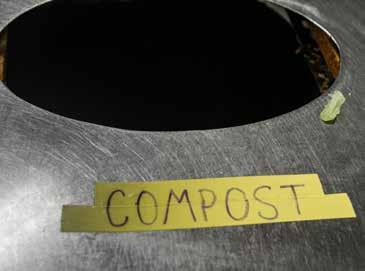
terial will need to be aerated regularly.
The ideal range for composting unsorted food waste within the drum is between 122°F and 140°F. At these temperatures flies will not ly eggs, weed seeds are destroyed, and pathogens are eliminated. Temperatures significatly lower than 122°F suggest that conditions inside the drum are not conducive for primary decomposition, and temperatures too far above 140°F will begin to reduce the overall species diversity of bacteria.
When proper primary decomposition is achieved (25-45 days), the material exiting the drum will be mostly stable, should have little ofensive smell, and should not attract flie, dogs, or rodents. This material can be used as topdressing for vegetable and flwer crops but because there are large quantities of larger organic molecules in the material, microbes borrow nitrogen from the soil to complete decomposition. This creates nitrogen starved conditions therefore supplemental nitrogen should be applied.
If you do not use the material as top dressing, it should be placed in a pile for secondary decomposition. This pile should be large (we recommend a pile that is at least 6 feet by 6 feet and four feet high), with the least amount of surface area possible, adding enough moisture to keep the pile damp but not soggy. These conditions will encourage the microbes to re-heat
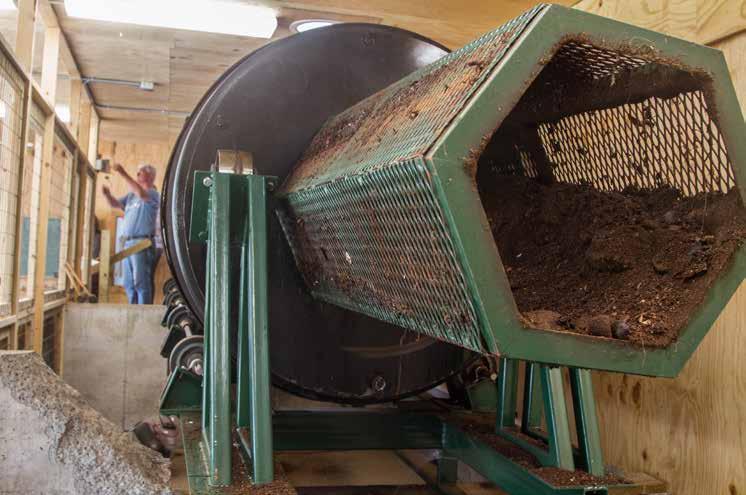
— The ideal range for composting unsorted food waste within the drum
the organic material. To a point, the larger the pile the better. Temperatures at this phase often reach 140°F. Watering and turning the secondary decomposition pile (or piles) will greatly aid the continuing decomposition process. Piles that are in the high temperature range will dry out fairly quickly. If the pile becomes too dry then the composting process stops, potentially producing odor and flyissues. Over the course of several weeks, temperature will begin to drop. This is a sign that the bacteria and bacteria-like organisms are dying off or going domant and higher-order organisms, including fungi, are beginning to proliferate. It is these higher organisms that break down the carbon containing molecules into much smaller molecules like
JOHN CULPEPPER john@adkaction.org
humic and fulvic acids. When added to soil, these compounds persist for years or decades, aiding water retention, cation exchange between the soil complex and plant roots, and helping to facilitate additional microbial life in the soil.
If compost will be bagged, it is important to allow the material to fully mature. Bagged and overly wet, immature compost will produce mold as well as foul smelling compounds. Compost that is stable will have a deep, earthy smell very similar to forest soil, has a high retail value, and is capable of making soils much more productive.

With a few caveats, just about any common organic material can be composted with this in-vessel design.
Below is a list of items that we have had success with and those that we have not had success with. Operators may wish to try other items but it is suggested that this be done with care, testing small amounts at a time until it can be determined if the drum composter is a good fit or the experimental feedstock. In some cases, a compostable product does not fully decompose during primary decomposition, but may decompose during secondary decomposition or by running the material through the drum a second time.
The following items have proven to do well in our composter:
• All unsorted food waste coming from kitchen meal prep and from plates after a meal (greens, meats, eggshells, bones, etc): Bones and shells come out clean but not decomposed. There is valuable calcium and magnesium in these items. After primary decomposition, we suggest that you crush these items and apply to soils. If selling compost, sending the crushed bones and shells back through the composter is recommended.
• Some paper towels. Ripping paper towels (brown or white) before adding them to the composter will prevent the paper from rolling into balls inside of the drum.
• Cofee grounds and filers: Cofee grounds, filers, tea bags, and paper towels are collected in a bucket next to cofee machines.
• Animal mortalities or animal offal: ll contents after chicken and turkey harvests are placed into the drum. This includes heads, feathers, feet, etc. For larger animal mortalities, Cornell University’s method of decomposing in wood chips is recommended. We have had success with this method for horses, sheep, goats, and pigs. For large animal parts after a harvest, larger parts are cut up before they go into the composter.
• Bags of spoiled or weevil infested grain and maggot infested food waste
• Large shredded craft paper bags
• Miscellaneous: Old cotton t-shirts, old leather shoes, belts, etc.
• Animal manures: We do not place cat manure in the composter, but have put large quantities horse, sheep, chicken, goat, and other manures in.
• Human urine mixed with wood pellets: We are in the process of exploring the viability of large-scale urine collection and composting in a separate facility. The environmental and cost benefits ae compelling.
• Hair or fur
• Weeds from our gardens: Given the bulky nature of weeds, they are typically composted in separate, open, static bay composting bins, however the composter could process them as well.
• Limited amounts of wood ash: This is supplied from our high efficiey wood biomass boilers on campus, the largest of which produces a black material that is believed to have many of the properties of biochar.
These items do NOT do well, or are incompatible in the drum composter:
• Wax paper or wax cardboard
• Large amounts of shredded paper: Shredded paper tends to ball up during rotation, creating conditions that don’t allow for decomposition.
• Fossil fuel based plastics: We are experimenting with compostable plastics, however early results indicate that they do not breakdown during our typical composter retention time. These products often need six months or more in a high temperature composting environment to fully break down.
• Paper plates: The retention time in the drum does not seem to be enough to process paper plates. A second run through the system might result in full decomposition.
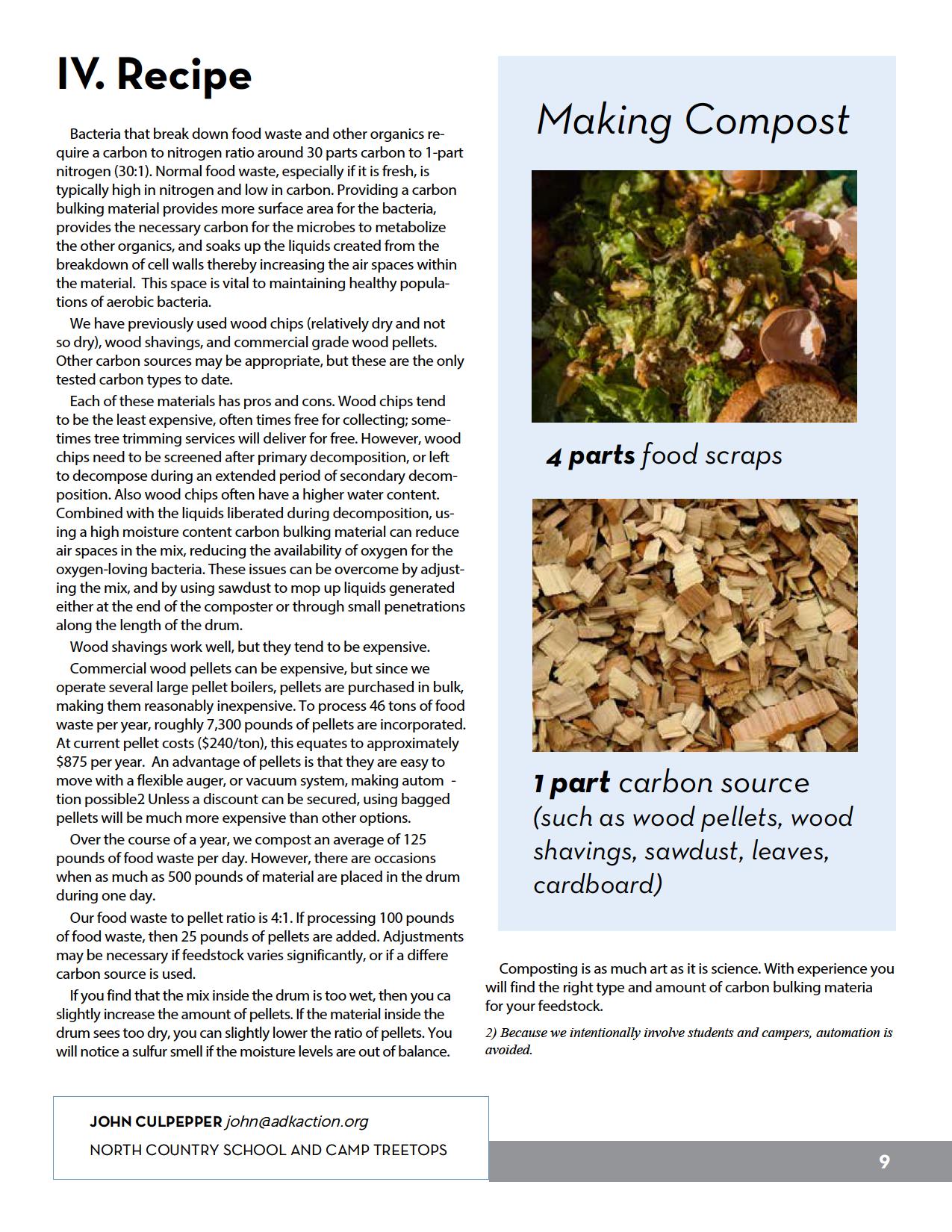
Each site will develop their own processes that meet their unique needs, however we are including an overview of our system to illustrate the general steps involved.
Because the microbes that break down food waste are already in the environment, it is not necessary to add purchased bacteria. However, it is never a bad idea to add a couple shovel loads of active compost when you begin to load your drum composter for the first tim. If available, using compost from more than one source insures that you have a wide variety of microbe species. Feel free to reach out to Tess Faller, our Garden Manager, for some of our compost that has recently exited our drum.
Once a day, unsorted food waste is collected in 8-gallon pails with lids and transported to the composter in a garden cart. We use more than two carts during the seven weeks of Camp Treetops when we are feeding approximately 300 people. The food waste is taken to an area next to the composter where it is weighed and recorded. The food waste is then dumped onto a concrete floor enclosed y a wooden bin.
With shovels or lawn edging tools, the food waste is lightly chopped focusing on larger scraps with intact skin, like apples and oranges. The weight of the food waste determines the amount of carbon bulking agent to add (see recipe section above). With flt shovels, the food waste is lightly mixed with the carbon bulking material (wood pellets), then placed in different 8-gallon containers. That blend is carried to the loading door of the drum and dumped inside.
After placing all of the food waste and carbon bulking material inside the drum, we add dry sawdust to the floor of the miing area to soak up liquids and grease. Sawdust is also added to any area under the drum where liquids accumulate. Once the sawdust has done its job, it is added to the drum to compost.
Before loading the blended mix into the drum it is important to measure and record the temperature inside. A thermometer is placed just inside the loading door to determine how well the composting process is going. We have also added two On-
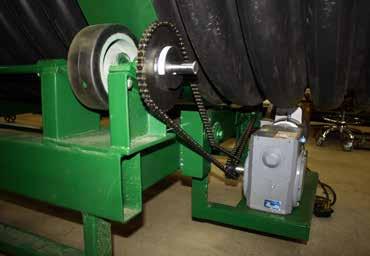
Care must always be taken when rotating the drum. The interface between the drive wheels and the drum, the chains and sprockets and close walls or ceilings represent pinch points. Those pinch points must be isolated or monitored to avoid injury. It is highly recommended that a momentary switch thereby stopping the drum rotation be housed within a locked cover for additional injury protection. Locating the switch to the side of the drum, provides a line of site of the entire system allowing the operator to release the switch if he or she determines that someone is getting too close to the pinch points.
site/HOBO temperature data loggers that travel with the composting material, recording temperature every fie minutes.3 Once the data loggers exit the drum, the data is downloaded and translated into graph form.
It is helpful to have a hoe or other tool to push the material away from the door as more blended mix is added. We use a tool called a Mcleod that serves this purpose well.
Once the food waste/carbon bulking agent is loaded into the drum, the loading door is closed. After the supervising adult ensures that no one is close to the composter pinch points, he/she will unlock the momentary switch door, and rotate the drum the appropriate number of times to ensure that it remains ½ full (each rotation lasts ~45 seconds). We rotate the drum 1-5 full rotations depending on the amount of material in the drum and how much material was placed inside the drum that day. If it is allowed to get more than ½ full, the number of rotations needed will increase substantially in order to move
JOHN CULPEPPER john@adkaction.org NORTH
the material to the discharge end.4 Determining how many rotations to give the drum each time material is placed inside the drum becomes easier with experience.5
During startup the drum is rotated until the top of the mixed material aligns with the bottom of the loading door, preventing material from falling out during the next loading cycle when the door is opened again. We painted a white mark on the steel band that the front drive wheel rolls against. This allows the operator to stop the drum in the right place without having to open the loading door and look inside.
Carefully consider where and how collection container cleaning will happen. It can be a messy job and collection of the small particles of food waste through a sieve or other process is strongly recommended. These scraps can then be added to the composter.
The amount of time that compost stays in the drum is determined by how much organic material is added each day. During times when a small amount of food waste is added fewer rotations are needed and the retention time is longer. When larger quantities of food waste are added, more drum rotations are needed and the retention time is shorter. Biological processes tend to slow down during winter, however supplemental heat can ofset this.
For us, the shortest retention time has been 20 days. The shorter the retention time, the less decomposed the material is going to be as it exits the drum. The opposite is true for longer retention times. 25-45 days is the average duration that it takes for material to travel the length of the drum. We monitor this by recording the date that a golf ball enters and exits the system.
In all cases, the goal is to have enough retention time, and a robust composting process, to stabilize the organic matter being discharged.
Since the drum is on an incline, during rotation material that has undergone primary decomposition falls out the discharge end. Secondary decomposition will then be necessary to break down the many round balls of un-decomposed organics and to finish beaking down large carbon containing molecules into stable organic acids. Secondary decomposition can be accomplished by placing the material in piles or windrows at a remote site, or at the exit point of the drum.
We allow exiting material to build up in a space that is approximately 12 feet x 8 feet, and to a height of about 3 ½ feet. The accumulated material is run through an electric trammel, however sifting the material on a wood frame, covered by ¼ inch metal hardware cloth will also work. The fine mterial from the sifting process is piled again to undergo additional primary decomposition and then secondary decomposition. Coarse

material from the screening process is put back into the composter. See “Composing Basics” for more information.
In a smaller space, like a 40-foot shipping container, the material should be taken to a storage area each day, or when needed, by wheelbarrow (double wheel wheelbarrows are more stable). The material can also fall into a large bin that can be moved by hand or with equipment once it is full. The ability to hold a week’s worth of discharged material before it needs to be removed is ideal.
Monitoring the smell of the material inside the drum and of the discharged pile helps determine how efectively the composting process is working. Strong, foul smells including the smell of ammonia is a sign that species of aerobic bacteria are dying out and anaerobic bacteria are becoming prominent. This is an indicator that the recipe needs to be adjusted.
Under certain conditions, flies can be ttracted to the compost operation. It is therefore important to have fly ontrol measures in place during the warmer months. (More on this in the miscellaneous section.)
3)Each time the drum is rotated, the temperature drops signifcantly, and it takes some time for it to stabilize and start climbing again. For maximum organic breakdown in the shortest time possible, the goal is to maintain an operating temperature of 120-140 °F as consistently as possible. We are looking for ways to reduce these dramatic temperature swings. Rotating the drum every other day helps, but rotating the drum every 3-4 days does not. This is likely due to decreased oxygenation due to decreased tumbling. Research is ongoing and encouraged by other hosts.
4)During decomposition, large quantities of water vapor and carbon dioxide are released, causing both the mass and the volume of the material inside the drum to decrease. Therefore, there is not a one-to-one ratio of material going in and material going out.
5)It may possible to determine a ratio between the amount of material loaded into the drum and the number of times one would have to rotate the drum each day to keep the drum ½ full.
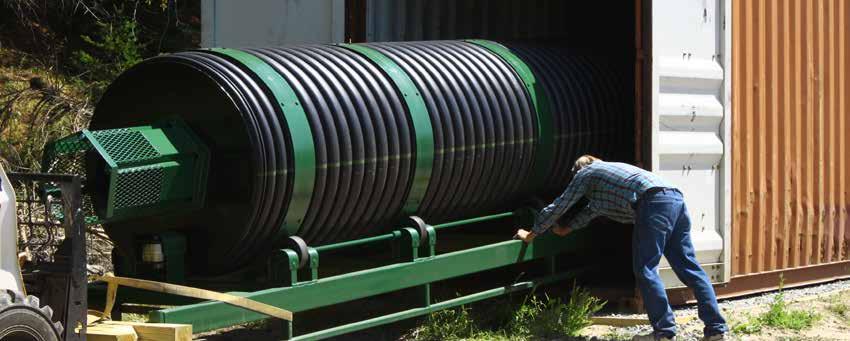
Our drum composter is designed to be housed inside a 40-foot shipping container (see details below), however the following guidelines apply regardless of what the composter is housed in.6
A 100amp electric panel will provide more than enough power for all of the needs of the composter
Install as many receptacles and circuits as you deem necessary, but must include
• One 220V/20A circuit and receptacle for the motor to be plugged into
• One spring-loaded momentary switch (double pole) that will only operate when the switch is being held down. This switch should be installed in such a way that the operator can look at the entire length of the drum when holding down the switch. This allows the operator to make sure that no one is near the rotating pinch points when the drum is rotating.
If you have 3-phase electric service, then we suggest that you run your drum motor with a 3-phase motor to reduce upfront and operating costs. Check with your local electrician for details.
• Non-motor circuits should be at least 15amp
• Miscellaneous plug loads (future use)
• Space heater sized to provide supplemental heat during the coldest months of the year (see below)
• Ventilation fan (see below)
• Lights (see below)
Under the right conditions, anaerobic bacteria will produce methane gas which does not have a detectible odor, however in a closed space it can be combustible. An exhaust fan running on slow speed all of the time, and on higher speeds during the summer to exhaust moisture and odors will ensure that harmful gases do not build up. We recommend installing a methane monitor to be attached to a light or sound alarm especially when installed in small vessels such as a shipping container.
If your composter is in a confined spae, like a shipping container, then a hardwired ventilation fan with rheostat, off switch, and intake grate sized to cool the container in the hottest parts of the summer and to ventilate smells and gases generated during the composting process is required. If not properly maintained, the composting process can build up ammonia or methane, which needs to be vented. The intake vent/ louver should be close to the discharge end of the composter. Our fan runs constantly.
For shipping containers, so that the roof is not compromised, both exhaust fan and intake louver should be sited on the sidewall of the container. The exhaust fan should be sited at the loading door end of the composter drum.
Site should be level, hard packed (gravel or pavement) and capable of handling a large truck maneuvering around to off load the container.
The opening of the drum could be as high as 36” (actual height is based upon the desired outflw height). Therefore, it is recommended that a platform be built to access the composter loading door. The surface area of the platform should safely and easily accommodate 1-2 people with 8-gallon buckets. Our platform is 6’x9’, located 31 inches off the round with 3 steps leading up to it.
Consider a 5kW heater (depending upon your building footprint) to keep the composter warm enough in the colder parts of the year (depending on where you are located), to maximize the efficiey of the composting process and the bacteria that do the work.
Flat profile ligts with plastic diffusers ork well. In the space of a shipping container, unprotected standard bulbs will likely get broken.
• 40-foot shipping containers can be purchased with two side-swinging doors on one end or both ends. The containers with only one set of side-swinging doors are less expensive. There are many places that can install a 6’ roll up door on the solid end. Both ends of the container should be locked when not in use.
• Having access to running water for washing compost buckets and other cleanup is very helpful. Since primary decomposition generates heat, that heat will dry out your pile. Having water at your site for primary and secondary decomposition is very helpful to keep the composting process going.
• Include space for a mixing area. Our mixing area is 3 ½ feet x 4 feet and is built out of rough sawn lumber. This mixing area is slightly larger than it needs to be.
• Insulation is not required, but would contribute to a more pleasant environment with fewer climate control needs.
For shipping container installations, there will be a total of 16 linear feet of available space once the composter has been sited within the container. The operator needs to consider how the drum will be situated. In the middle of the shipping container? With more space on one end than the other? Consider the throughputs of the system and how it will be fed and how
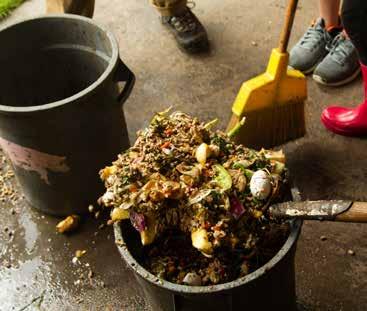
• Consider posting warning signs at the pinch points of the system
• Consider how you plan to restrict access to the container doors when it is unattended
• Develop a plan to restrict the ability of anyone to be near the wheels and gears when the system is in operation. A loaded composter is heavy and unforgiving. If a hand or finger end up near a pinc point while the drum is moving, they will likely be severed. While restricting access to the pinch points is critical, it will also be important to be able to gain access to the wheels, chain, motor, and reduction drive for future repair and service.
the compost will be moved out of the container. The composter can be raised off the round to varying heights. Consider how the compost will be moved out of the container (forklift, wheelbarrow, tractor, etc.) to determine how high you would like the end chute to be off the floor of th container. Within an 9’ 6” high cube shipping container, the highest the discharge end can be raised is approximately 4’6”. The higher the drum is raised, the higher the platform should be on the loading door end.
6)Our composter is located in a space that is approximately 36 feet wide, by 20 feet long, with two concrete pony walls that create three separate bays, each 12 feet x 20 feet. The ceilings are insulated and the walls are lightly insulated. Even though the winter will usually produce one or two -30°F days, the building is able to maintain comfortable operating temperatures within the drum with only a portable electric heater for backup heat.

We have found that maintenance is infrequent and fairly simple and includes the following:
Listen to changes in the sound of the composter as it is rotating. A squeaky sound may be an indication that one of the wheel bearings is failing.
Clean around the door to ensure that it closes fully.
Monthly
• Oil the chains, as needed.
• Check chain tension. If too loose, adjust by loosening the bolt to add pressure.
• Apply grease to the zircon fittings on the beaings, as needed.
• Check the level of the oil in the gear reduction drive.
• Change the oil in the gear reduction box every 2-3 years.
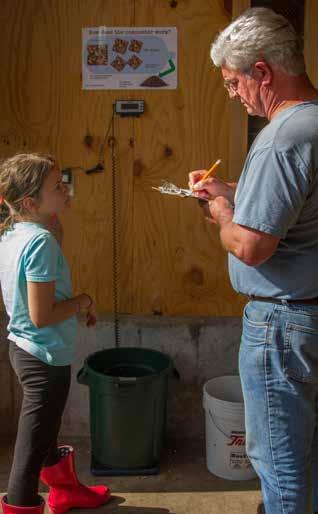
• US Composting Council
• Local master composters
• Local commercial composting businesses
• Community Scale Composting Systems; A Comprehensive Practical Guide for Closing the Food System Loop and Solving Our Waste Crisis, by James McSweeney
• EPA – metrics and GHG estimates
• Penn State Composting Lab
NYS resources
• NYS Association for Reduction, Reusing and Recycling: NYSAR3
• NYS Department of Environmental Conser vation: NYSDEC
• Pollution Prevention Institute
• Cornell Cooperative Extension Compost Resources
Various support materials are available from John Culpepper and on our websites: northcountryschool.org camptreetops.org
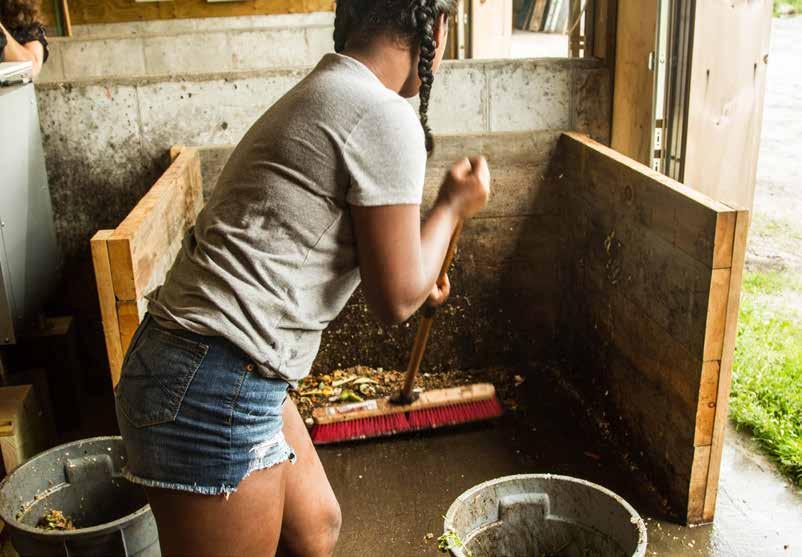
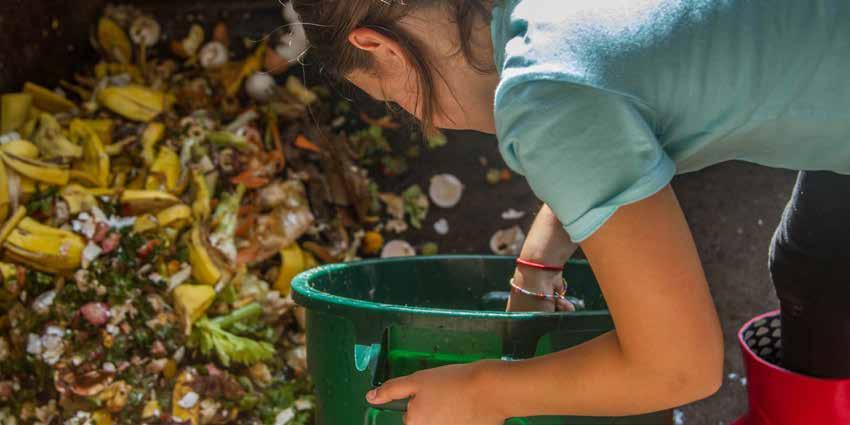
Food waste that is composting efectively will generate enough heat to prevent flies fom trying to lay eggs in the material inside of the drum. However, because the inside of the loading door tends to be somewhat cooler than the decomposing material, maggots can sometimes be found on the inside of the drum loading door. Those maggots can be scraped off with a plastic dust pan, placed inside the drum and covered with hot, decomposing food waste.
Occasionally maggots have been seen in the material that is discharged from the drum. Typically, this means that the material is not piled high enough to encourage reheating or that it is spread out too much, or the material has not been kept moist enough.
It is important to keep all spaces where food waste is temporarily stored or processed clean and dry. Spreading dry sawdust on the floor whee food waste is chopped and mixed with the carbon bulking agent will soak up excess liquids, and if brushed around with a broom, the dry sawdust will pick up grease that comes from the waste.
Parasitoids purchased from a supplier can be placed around the compost facility. The tiny parasitic wasps hatch and look for fly lava to parasitize. We purchase parasitoids through Spalding Labs hyperlink. A schedule can be set up to receive parasitoid larvae every few weeks.
While there are many commercial flytaps to choose from, Victor Fly Magnet reusable traps have proven highly efective for us. During problematic summers these traps capture thousands of flie. Dead flies ae added to the composter or fed to chickens.
While rodents don’t necessarily eat the compost, a warm facility is likely to encourage mice or other vermin. Commercial traps work well however homemade mouse traps using 5-gallon buckets or other containers full of water are also efective. Dead mice can also be composted.
Whether producing compost for sale or use on site, it is a good idea to test for nutrients and other variables like maturity. We use the Penn State compost lab.
Each state and municipality has diferent requirements for permits associated with composting. We strongly recommended that you contact your local DEC and code enforcement ofces for details.
Local code officials will likelyequire a conversation about an in-vessel compost facility, and may have restrictions on the use of 40-foot shipping containers, and/or require an electrical
JOHN CULPEPPER john@adkaction.org
inspection. Talking with neighbors early in the planning stages is highly recommended and can avoid the potential for ill will.
During times when the drum is not being loaded regularly, it is important to rotate the drum one time every other day to keep the material mixed and oxygenated. If a facility is likely to be inactive for weeks at a time, then once every 3-4 days may sufce. If you anticipate months of inactivity (such as summer vacation), partnering with parents, local restaurants or other facilities to receive food waste once a week would help maintain the biological processes. The presence of a responsible adult when the drum is rotated however is a must.
Without good mass and volume data it is difficulto know how much food waste is being processed or how much compost is created. An outdoor appropriate floor scale tht can be tared, allows the weight of the bucket or container to be automatically subtracted. We use the ACCUTECK 440lb heavy-duty digital metal industry shipping postal scale (ACB440) which costs approximately $45.
Compost thermometers will allow for temperature measurements at various depths in the drum and finishing pil. We purchase thermometers from Reotemp for approximately $25.
We purchased two temperature data loggers, which are zip tied to a whiffle ball and avel with the mixed material from loading end to discharge end. When the data logger/whiffl ball combination comes out of the drum, the data logger can be connected to a USB cable and the data downloaded for analysis. We use the HOBO, U12-015 model. Each data logger costs approximately $285 including shipping. When the battery runs low, the unit has to be sent back to the company for a new battery. The data loggers we use been have been in continuous operation for over 12 months and both have lots of battery life remaining. The data can be viewed and printed either in raw form, or in graph format and can be enormously helpful in understanding the composing process within the drum.
Determining retention time can be done with a golf ball. Assuming the golf ball travels at the same rate through the drum as the other material, the retention time is the time it takes for the golf ball to exit the drum. We have tested a single golf ball compared to two golf balls (screwed together to prevent rolling) and loaded on the same day. They seem to come out at about the same time.
It is important that the responsibility for the operation of the composter not be spread over several people. Ideally, there is one person who is able to train new people, deal with problems
that emerge, monitor safety, perform maintenance, be responsible for all operations, etc.
In the event that all contents need to be removed, the end screen assembly is removed, and the drum is rotated until all contents are out. Increasing the drum angle will assist with this process. The system is designed in a way that most all parts, with the exception of the drum itself, are able to be replaced without emptying the drum.
Composting food waste is deeply connected to biology, microbiology, agriculture, environmental science, horticulture/ plant science, social studies, physics, chemistry, business, and many more field. Operating a composter has the potential to be a significat laboratory for student learning. Contact us for supplemental materials including lesson plans, presentations, videos, and general promotional material.
TEMPERATURE: Data from the Onsite HOBO temperature data loggers has identified may potential research questions including: What happens to the temperature inside the material within the drum when the drum is rotated? Why does the temperature change when the drum is rotated? What happens to microbial species diversity if the temperature gets above a certain point, and why? What is the relationship between temperature and number of rotations per day, and why? How much is mass reduced when the material goes through the drum, and why? How much CO2 is released during primary decomposition? Other than bacteria, what additional type of microbes exist in the drum, and does the type of organism change with changing temperatures?
COMPOSTABLE PRODUCTS: Conversations and concerns surrounding compostable products such as silverware and food containers are occurring on multiple levels. Researching how best to compost such products or identifiction of products that more readily break down would be extremely useful.
FEEDSTOCK: University researchers and others have expressed interest in partnering to study the efectiveness of this design, its ability to compost other organics, and the use of a drum composter to compost human urine.
REDUCING GREENHOUSE GAS EMISSIONS: When food waste (and many other organics) are landfille, anaerobic decomposition within the landfill poduces methane. According to the US EPA, methane is 28-36 times more potent as a greenhouse gas than carbon dioxide. Composting food waste not only yields a valuable soil amendment but also reduces your carbon footprint. By composting approximately 50,000 pounds of food waste per year. We estimate that we reduce our carbon footprint by approximately eight metric tons of carbon dioxide equivalent per year.
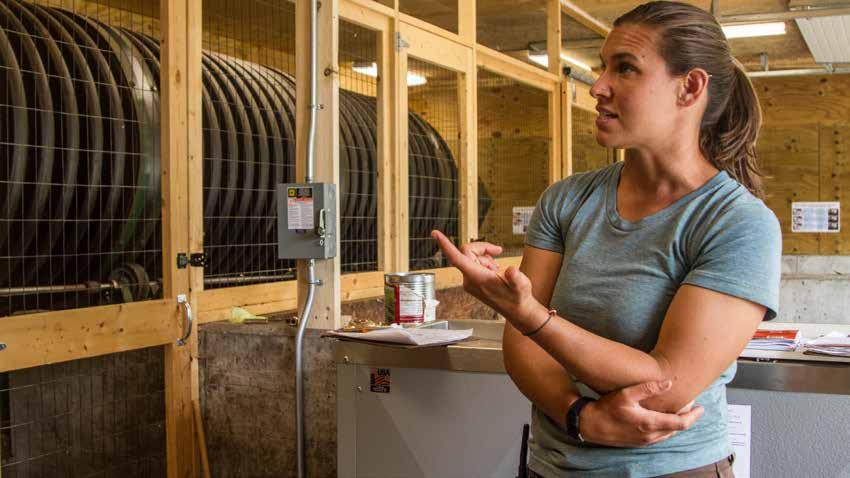
Depending on the amount of food waste, loading the composter, for one adult, takes 10-15 minutes/day. Managing the compost produced, and acquiring the carbon bulking material depends on various factors, but will likely take an average of four hours/month of additional time.
• Read operation manual
• Identify point person to manage unit and input/output process
• Learn basics of the microbiological process
• Customize recipe
• Can range from zero to 200 pounds/day (occasionally more)
• Consistent feedstock is best, but not necessary
• Ability to utilize the finished poduct
• Moisture content
• Temperature
• Flies
• Rodents or other pests
• Proximity to power – 3 phase ideal but not required
• Proximity to water for washing composter, buckets, tools, etc.
• Access to a road or parking lot for food waste delivery
• Remote locations could operate a composter on generator or PV/battery power
• Level site under cover
• Avoid locations that could ofend neighbors
Avoid proximity to environmentally sensitive areas such as wetlands or rivers that might trigger need for permits
0-400 lbs of food scraps delivered to system 1
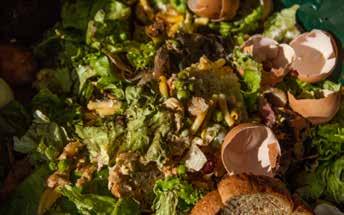
7
6 Maintain temperature between 110F – 150F. Rotate more frequently to lower temp
Day 25-45: Compost exits drum. Finished material either used immediately for top dressing or sifted and moved to a curing location for sale or use.
2 Scraps are chopped with hand held lawn edgers or other sharp implements
5 Switch on motor to rotate drum for one or more rotations
3 Scraps are mixed with wood chips or wood pellets (or other high-carbon material) in a 1:4 ratio

4 Food scrap carbon blend is loaded into loading end of composter